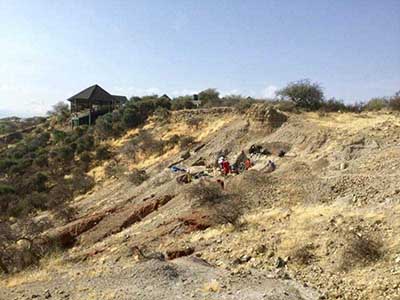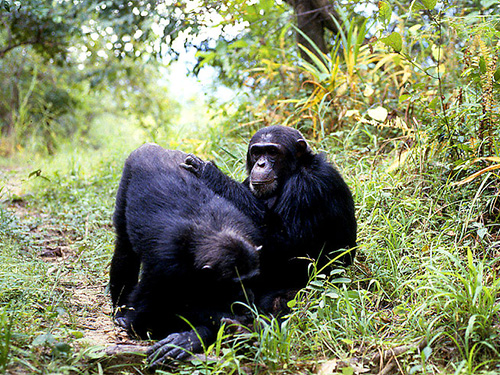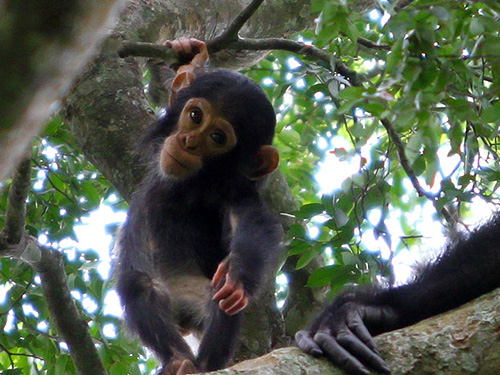
A young chimpanzee is observed at the Toro-Semliki Wildlife Reserve
in Uganda during the ongoing research of the Semliki Chimpanzee Project.
Photo by Kevin Hunt.
Modern Primate Research
Kevin D. Hunt, professor at Indiana University, founded and directs the Semliki Chimpanzee Project (SCP), a research and conservation initiative on the Toro-Semliki Wildlife Reserve in Uganda (not to be confused with the Semuliki National Park). When founded in 1996, SCP became the 13th permanent chimpanzee research site, only the second to focus on chimpanzees living in the same dry habitat of the earliest human ancestors, and the only active dry-habitat site. SCP has as a research mission better understanding early human evolution, particularly the origin of bipedalism.
The australopiths, the earliest members of the human lineage, lived in a dry habitat similar to that of Semliki. Hunt speculated that chimpanzees confined to a dry habitat might behave and might even have some of the physical characteristics of australopiths. The unusually peaceful chimpanzees at Semliki cope with their dry habitat by standing bipedally often, by traveling over immense distances in search of food, and by digging drinking holes during the dry season.
Professor Hunt has recently published a book, titled Chimpanzee: Lessons from Our Sister Species, in which he presents everything we currently know about chimpanzees: from their discovery and why we study them, to their anatomy, physiology, genetics and culture. The text is beautifully illustrated by the author and infused with examples and anecdotes drawn from his thirty years of primate observation. It is an excellent read for anyone interested in chimpanzees and modern primate research. The book is available for purchase from Amazon.
Professor Hunt's Semliki Chimpanzee Project research has revealed that both the anatomy and behavior of the Semliki chimpanzees is unique. Some examples of their unique habits and qualities are listed below.
• Greater frequencies of bipedal locomotion and posture compared to other chimpanzees
• Largest community territory of any known population, 174 km2 or 3 times the typical area
• With 29 males, Semliki has the 2nd largest male cohort known (after Kibale-Ngogo)
• Semliki chimpanzees are less aggressive than other chimpanzees, as exhibited by the small number of injuries they inflict on one another; they have, e.g., few ear bites
• Semliki chimpanzees may have peaceful relationships with neighboring groups, in contrast to the violent and deadly relationships found among other chimpanzee populations
• They appear to hunt less often than any known population
• Semliki chimpanzees dig drinking wells, possibly to filter out pathogens found in the low-quality water that is the only drinking water available deep in the dry season
• SCP has recovered a number of skeletons. Semliki chimpanzees are the only chimps known to have knee joints morphologically similar to those of humans and australopiths
• Semliki chimpanzee mandibles and faces are robust, like australopiths, possibly because their diet has a high proportion of tough seeds and fibrous piths and bark
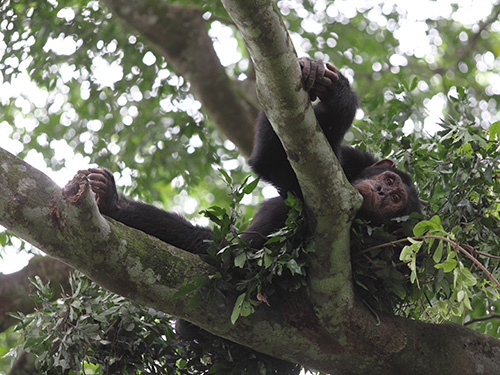
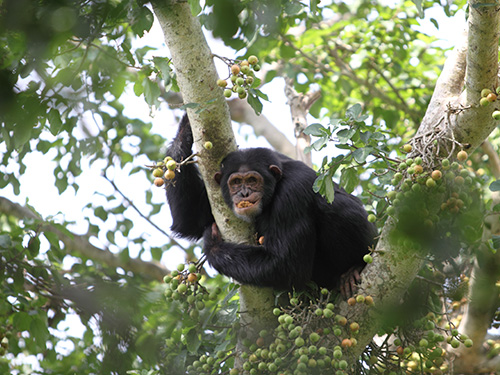
Left: A male Toro-Semliki chimpanzee in his nest.
Right: A Toro-Semliki chimpanzee forages in a fig tree.
Photos by Kevin Hunt.

